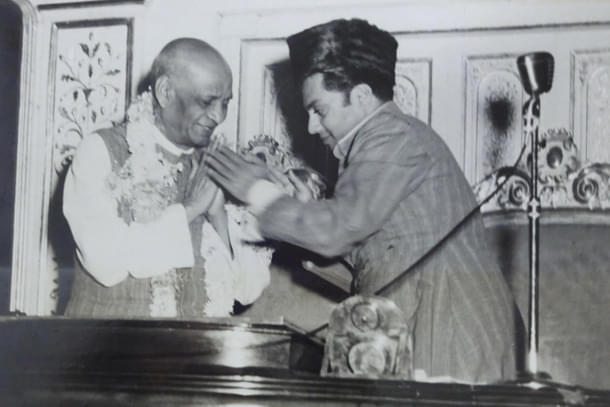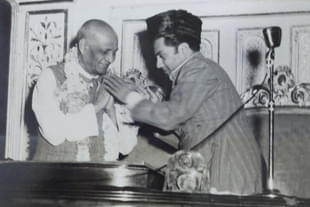Politics
In Defence Of The Maharajas
Arunansh B Goswami and Sumit Kaushik
Nov 09, 2024, 05:07 PM | Updated Nov 15, 2024, 05:34 PM IST
Save & read from anywhere!
Bookmark stories for easy access on any device or the Swarajya app.


In a recent article in The Indian Express, titled “A new deal for Indian business,” the leader of opposition in the Lok Sabha, Mr Rahul Gandhi, alleges that Indian Maharajas were hand in glove with the East India Company (EIC) and were bribed for their support.
His generic and vituperative opinion about the erstwhile royal families has indeed caused great outrage amongst them, and understandably so, leaders who hail from these families have replied strongly against this affront.
While on one hand he claims to be anti-monopoly and pro-competition in business in his article, on the other hand his party, the Indian National Congress, is known for the institutional hurdles that prevent the actual and substantive rise of competent and capable politicians.
The grand old party is monopolised de facto by the Nehru-Gandhi family. Even after the aforementioned logic of Mr Gandhi of the alliance between the EIC and the Maharajas, the “first family” of the Congress did not hesitate in using the descendants of the same erstwhile Maharajas in the past and continues to use them today for their political advantage.
Mr Gandhi’s Congress made several Maharajas and Rajas chief ministers of Congress-led state governments and several as ministers in the Union government, but now, surprisingly, Mr Gandhi has reached the conclusion that the Maharajas were allies of the EIC and it choked India by partnering with them.
From the Anglo-Mysore and Anglo-Maratha wars to the Anglo-Sikh wars and more, the list of Maharajas, Rajas, and Nawabs who struggled against the British in India is indeed long, which is why most scholars would find Mr Gandhi’s opinion as politically motivated and biased against the erstwhile rulers. Not only did they struggle against the East India Company, they funded the initial industrialisation of India.
In this article, I would like to especially focus on the Scindia dynasty. Scindia Marathas struggled not just against the British but even against Portuguese colonialists and went on to become Maharajas of the top 21-gun salute state of Gwalior.
The great-grandfather of Mr Gandhi, Pandit Jawaharlal Nehru, wrote in his book The Discovery of India, “In the greater part of India, the Marathas had been opponents of the British.” According to him, it became clear as the eighteenth century approached its end that struggle lay between the only two powers that counted — the Marathas and the British. All the other states and principalities were subordinate and subsidiary to these two.
According to Mr Nehru, Marathas produced a number of very able men, statesmen, and warriors, among them Mahadji Scindhia (Scindia) of Gwalior.
About the Maratha warriors, Nehru wrote, “Their rank and file were good, seldom deserting a post and often facing certain death unmoved.” These Maratha warriors became Maharajas of princely states like Gwalior and Baroda (two top 21-gun salute states) who played an important role in the struggle against the British.
A close friend of Maharaja Madhavrao II Scindia (Madho Maharaja), Maharaja Sayajirao Gaekwad III of Baroda was a vocal supporter of freedom fighters like Dadabhai Naoroji, Lokmanya Tilak, Mahatma Gandhi, Mahatma Phule, Dr Ambedkar, Madan Mohan Malviya, Karmaveer Bhaurao, Veer Savarkar, and Maharshi Shinde.
Gaekwad not just sponsored the education of Dr Ambedkar but also gave him a job, while Congress had obstructed Dr Ambedkar from entering the Lok Sabha on two occasions, defeating him in the 1952 and 1954 elections.
One of the biggest and most humiliating defeats heaped on the British in India was by Maharaja Mahadji Scindia at the battlefield of Wadgaon in Maharashtra during the first Anglo-Maratha war. It has been stated that if Mahadji had not won the battle of Wadgaon, then the British would have ruled 40 years before 1818.
An Asian army under the command of a Scindia warrior had defeated a European world power. Maharaja Mahadji Scindia modernised his army to fight against the British; he even asked the EIC to pay taxes for Bengal, an Indian province that was being occupied by the EIC.
Emrys Chew writes in his book Arming the Periphery: The Arms Trade in the Indian Ocean During the Age of Global Empire (published by Palgrave Macmillan) that “Mahadji Scindia proceeded to establish his own military-industrial complex near Agra.”
The Maratha ordnance factories incorporated relatively sophisticated indigenous technology and involved local manufacturers. The English EIC was so alarmed by these developments that it forbade Britons to serve as gunners with the Marathas and sought to curtail the trade in muskets.
Chew writes, “Scindia, assisted by French and Portuguese military advisers, went on to create one of the finest armies in India—including the 27,000-strong brigade known as the 'Deccan-Invincibles' supplied from the arsenal at Agra. By combining these new weapons with new battlefield tactics, the Marathas were able to mount a formidable challenge to the British between 1775 and 1818, over the course of three Anglo-Maratha Wars.”
Maharaja Mahadji Scindia’s successor, Maharaja Daulatrao Scindia of Gwalior, fought against the British in different parts of India. He fought against Arthur Wellesley, who later defeated Napoleon, and also Lord Lake, a veteran who possessed wide experience of war. Till 1803, Maharaja Daulatrao Scindia even controlled Delhi.
Lord Wellesley wrote that “the entire reduction of Scindia’s power would certainly afford considerable security to our interest” and initiated an aggressive policy against him. War against Scindia was declared on 7 August 1803, and his army fought bravely at different fronts across India, from Gujarat to Delhi and from Maharashtra to Rajputana.
Some Congressmen have alleged that Maharaja Jayajirao Scindia supported the British during 1857. They should read the history of Jayajirao without prior political bias. Scindias’ struggle against the British was not over, and this was a cause of concern for the colonialists, and, therefore, Lord Ellenborough, governor-general of India, directed Lieutenant-General Sir Hugh Gough to assemble forces to converge on Gwalior, ruled by a young Maharaja Jayajirao Scindia under the regency of his mother Shrimant Tarabai Raje Scindia.
On 29 December 1843, in two simultaneous battles, at Maharajpur and at Punniar, British East India Company forces defeated Jayajirao Scindia’s armies. On 31 December, a treaty was signed, and arrangements were made for the occupation of Gwalior fort.
As per the descendant of martyr Tatya Tope (who fought against the British in the war for Indian independence of 1857), Mr Parag Tope, in his book Operation Red Lotus, Jayajirao Scindia gave full support to Tatya Tope, who acted as the link between Gwalior Durbar and freedom fighters in Kanpur and Jhansi.
The British punished Scindia by not returning the Gwalior fort to him after crushing the war for Indian independence in 1857 and gave back the fort of Gwalior to Scindia only as late as 1886. The question is, why? It is because they did not trust him.
Jayajirao played an important role in the development of Indian railways that was utilised by several Congress leaders. In 1872, the Scindia State lent Rs 75 lakh for the construction of the Agra-Gwalior portion of the Great Indian Peninsular Railway. In the following year, a similar amount was advanced for the Indore-Nimach section of the Rajputana-Malwa Railway.
According to V P Menon, former secretary to the Government of India, who was closely associated with the process of the integration of Indian states under the leadership of Congress leader Sardar Patel, “The industrialisation of the country in its early stages owes a good deal to the House of Scindias, and every deserving venture had the support of the House of Scindia.”
Menon wrote, “The rulers of Gwalior have not, as a rule, been prone to extravagance. Successive rulers had, in fact, exercised the greatest economy in their administration. When the Government of India integrated Gwalior, apart from cash balances amounting to Rs 3.09 crore, we inherited two funds amounting to about Rs 17 crore that the Scindias had built up; one was the Gwalior Investment Fund and the other was the Gangajali Fund.”
In an article published in the Times of India in the year 1926, Maharaja Madhavrao II Scindia was addressed as “Indian Carnegie,” and according to the former resident editor of the Times of India, Mr D R Mankekar, during the 1922 non-cooperation movement, Scindia sent to Mahatma Gandhi an oral message through his home minister, Sadashivarao Pawar of Dewas, Jr, conveying Scindia's affectionate regards, plus a box containing lots of money as his donation to the struggle against the British.
Mr Gandhi writes about the “New Deal for Indian Business.” It was in fact Maharaja Madhavrao II Scindia, known popularly as Madho Maharaja, who brought the “New Deal for Indian Business” by supporting Swadeshi enterprises and cottage industries.
To help the Swadeshi industry, Gwalior’s first Chamber of Commerce was established at Lashkar in 1906 after Madho Maharaja pointed out to the commercial community the advantages of such a Chamber, a matter which the Maharaja had investigated during his visit to England in 1902. Now this Chamber of Commerce is known as the Madhya Pradesh Chamber of Commerce and Industries.
Not just Madho Maharaja but even his son Maharaja Jiwajirao M Scindia promoted Indian businesses, especially small businesses and cottage industries; he had set aside Rs 50,000 in the year 1940 for granting loans to small-scale industries.
For the economic development of the Scindia State, Maharajas built quality infrastructure, including airways, railways, and roadways. Madho Maharaja conceived the idea of establishing duty-free zones at different centres in the state to facilitate the movement of trade. The idea was put into practice at Ujjain by the Council of Regency in 1928, and so successful had the scheme been that Madhonagar, as this freeganj was named, had become a unique modern settlement on the outskirts of the old city.
Apart from cottage industries, even big industrial houses like Tatas and Birlas, who were then competing against British capitalists, were supported by Indian Maharajas like Scindias. Madho Maharaja invested a princely sum of 400,000 pounds for the establishment of Tata Iron and Steel Company. The Maharaja also helped TISCO with a loan of Rs 10 million when it faced its worst crisis after 1922.
Mircea Raianu writes in his book Tata: The Global Corporation That Built Indian Capitalism, published by Harvard University Press in 2021, that “Tata Hydro-Electric Company was floated with exclusively Indian capital. Its shareholder profile resembled that of TISCO. Subscriptions included 40 lakhs of rupees from Maharaja Scindia of Gwalior and 10 lakhs of rupees from Maharaja Gaekwad of Baroda.”
Even though he was son of a Maharaja, Jiwajirao Scindia started his civil career as a village patwari (village accountant), just as his military career had begun as a rupee-a-month private. During his regime as a patwari, he surveyed the village of Shankarpur in Ujjain, preparing all the charts and papers himself.
Like Scindias, several other erstwhile royal families contributed in different ways to the struggle against the EIC and early industrialisation of India, about which several scholars have written over the years. Mr Gandhi’s allegation against the royal families is indeed erroneous and has hurt the descendants of erstwhile Maharajas, many of whom played an important role in strengthening the Indian National Congress as politicians in different states of India.
Arunansh B Goswami, Head, Scindia Research Centre, Scindia (Jai Vilas) Palace Gwalior. Sumit Kaushik, a PhD candidate at OP Jindal Global and a social impact consultant.




